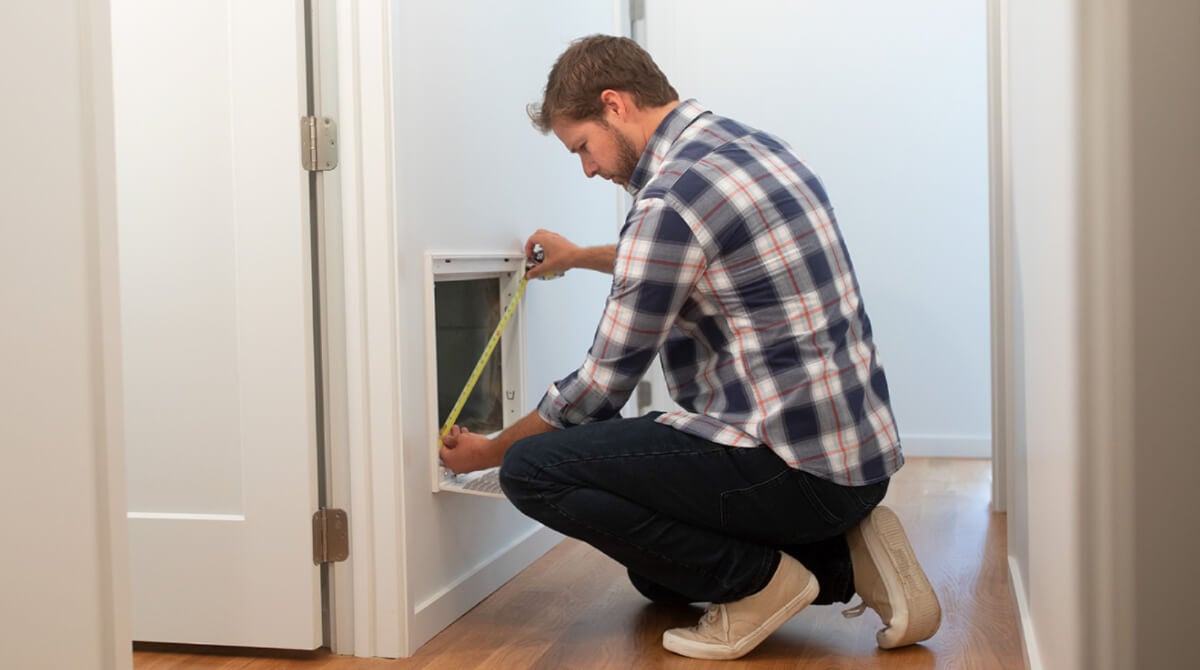What is an undercut? What does nominal mean? All the answers are right here.
One of the more needlessly confusing elements of home wellness is air filter sizing. We didn't make it this way, but we are making it is as simple as possible for you right here. Let's get started.
The two types
To understand air filter sizing, you first have to understand that there are two primary types of air filters.
- 1-inch and 2-inch air filters
- Whole house air filters
Home air filters are the ones that go into your wall in the air return; although, in some homes, they can go in the ceiling or into the ductwork itself. Your "air return" is aptly named—it's where "air returns" to your HVAC system from inside your home. Most filters for your return are 1" thick. While 2" filters are found in some homes, it's a lot less often.
Whole house filters usually go into an air handler, which is typically situated next to your HVAC system itself. In some homes, these go directly into the ductwork too. It's worth noting that, while you usually only have one, it's possible to need more than one whole house filter for your home. Whole house filters always have a thickness of 4, 5, or 6 inches.
You may have noticed that we did not mention 3-inch filters. While 3" filters technically do exist, they're particularly rare. If you need a 3" filter, you are special.
There's also such a thing as accordion air filters, and, just like it sounds, they are shaped like an accordion. If you have one of these in your home, we sell those too, but...well, that's just weird.
Air Filter Sizes: Length and width
1" and 2" refers to the thickness or depth of the filter, which we'll get to in a minute. First, let's talk about length and width. Length and width are technically interchangeable, but for discussion purposes, a 12x20 is 12 inches long and 20 inches wide. It's a very common size that is easy to find, and it's on a short list of sizes that are common enough for air filter companies like us to keep in stock. Some other common sizes are:
- 12x12x1
- 12x20x1
- 12x24x1
- 14x14x1
- 14x20x1
- 14x24x1
- 14x25x1
- 14x30x1
- 16x20x1
- 16x24x1
- 16x25x1
- 18x18x1
- 18x24x1
- 18x30x1
- 20x20x1
- 20x24x1
- 20x25x1
- 20x30x1
- 24x24x1
- 24x30x1
If you have a 1" or 2" air filter that is not on this list, you'll likely need a custom cut, and the hardware store definitely can't help you here. We've got you covered, though. With our custom air filters, there are 66,000 possible different sizes. We know! That's a lot.
To put 66,000 in perspective, that's roughly the population density of Manhattan per sq mi. That's also approximately how many Orangutans are alive today. Take those facts to trivia.
Undercuts and roundings
A 20x20x1 air filter is actually 19-¾" x 19-¾" x ¾". This is what is known as the undercut. All 1" and 2" filters are undercut by a quarter of an inch to provide a little bit of leeway to ensure it fits into the air return without being too big. This includes custom sizes, so a 27-⅜" x 23-⅝" x 2" (which is the weirdest size we could think of) is actually 27-⅛" x 23-⅜" x 1-¾".
At SecondNature.com, you'll see an actual size that shows the undercut when you enter a custom size. You'll want the custom size you pick to be the size of your return measurements, which allows the actual size to be a quarter-inch less.
Undercuts exist on whole house filters as well, but not in the same way they do for 1" and 2" filters. In fact, undercut is a bit of a misnomer when it comes to whole house air filters. These are actually just rounded to whole numbers in a somewhat arbitrary fashion. Allow us to explain.
Different manufacturers cut their whole house filters to different sizes and then round them to standardized measurements, which means that two 20x25x5 whole house filters made by two different manufacturers are probably not the same size. Below are some examples:
- Honeywell has a 20x25x5 is actually 19-3/4" x 19-7/8" x 4 3/8"
- Filtrete has a 20x25x5 is actually 19.75" x 24.4375" x 4.69" (seems like they have some pretty fancy rulers over there)
- Lennox has a 20x25x5 is actually 19-3/4" x 24-3/4" x 4-3/8"
And that all makes total sense...?
Because of this, it's necessary for those of you that need a whole house filter to know the exact filter size you need. If you can't find that on the filter, you can provide Second Nature with the nominal size and the brand that you had previously been using, and we'll be able to find the filter you're looking for.
Nominal vs. Actual size
All filters are sized two different ways. Yep, you read that correctly. All filters have an actual size and then a nominal size. The actual size is the exact dimensions with no rounding; whereas, the nominal size is the rounded dimensions of the filter. This means that on 1" and 2" air filters, the nominal size does not include the undercut, and the actual size does include the undercut. On whole house filters, the nominal size is the rounded size, and the actual size is just the unrounded. Pretty easy stuff here.
Sizes can be reversible
If you measure your vent and find that you need a filter with a nominal size of 30x20, you'll find shortly thereafter that there is no such thing as a 30x20. There is only a 20x30, and that is what you actually need. Whether the pleats on the filter run horizontally or vertically won't impact the effectiveness of your filter, so the number of unique air filter sizes on the market can simply be cut in half by always listing the smaller measurement first instead of having a 20x30 and a 30x20 as two completely different products. If you find that you need a 15x34, grab yourself a 34x15 and just rotate it 90 degrees. It's the same thing.
And that's how air filter sizes work. It's probably a little more complicated than it needed to be, but we try to make it easy. Now you'll never be confused by things like undercuts again.
tl;dr: air filters have weird sizes. Leave the rest to us—we'll make sure the right ones get to you right when you need them.
refrigerator water filter reduces.
Topics:




